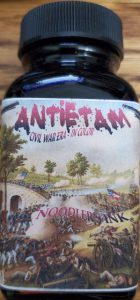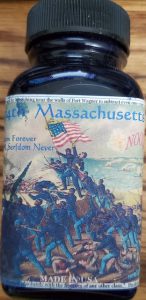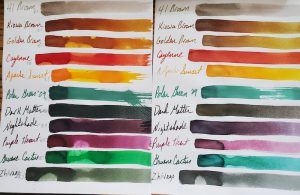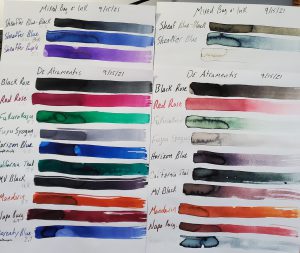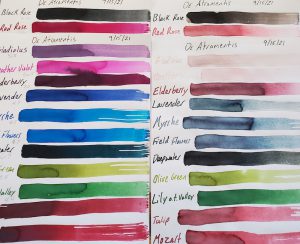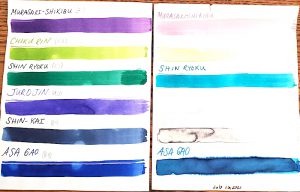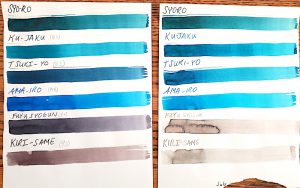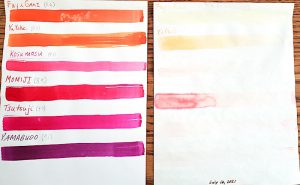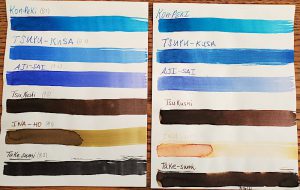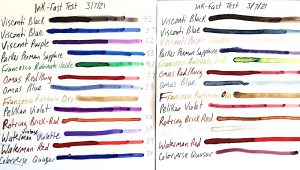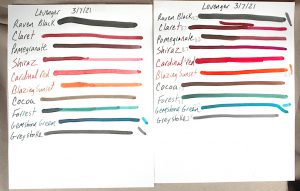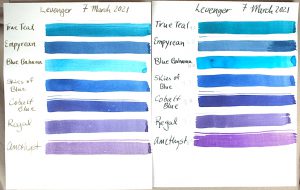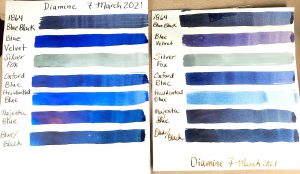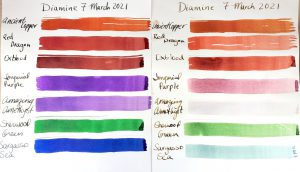For your writing pleasure, we have tested 10 more Noodler’s-brand inks. In Part I we delved into the various controversies, merits and problems with Noodler’s Ink. To read about that, please click on the Part I link.
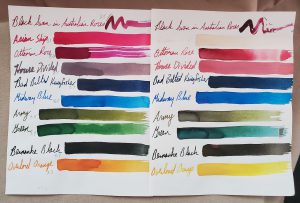
10 Noodler’s inks are on display here as a color-fast testing measure. The sheet on the left has the test proof that was stored in darkoom. The page on the right shows how some of the inks faded after 9 months in the sunlight.
Today’s ink spent 9 months in our sunniest window for a light-fast test. We also tested them for a pH reading, to verify or deny Noodler’s claim that all of its inks are pH neutral.
Let’s start with the color-fast (or light-fast) testing. It is always interesting to see what colors fade. “Black Swan in Australian Roses” is a red-black color that held up really well under prolonged UV exposure–hardly any fading or change in color. “Asian Ship” is a stunning deep pink. Unfortunately, it faded to nearly invisible. “Ottoman Rose” is a lovely purple with dark undertones. However, it fades rather badly in sunlight to a red-brick color, though shaded lines fade almost completely.
Another American Civil War-themed ink is called “House Divided.” It s a gray ink with some blue-ish undertones. On our Rhodia test pad it seemed to be surprisingly feathery. When it set in the sun for 9 months, it faded to a pale reddish pink…a fitting change for an ink based on the bloodshed of the war.
The blue inks we tested are surprisingly strong. “Bad Belted Kingfisher” is a nice dark blue that some might say borders on blue-black. It definitely doesn’t seem to lose an ounce of color. “Midway Blue” is one of the many World War II-themed inks. It is a bright, medium blue, which also doesn’t seem to fade in the sun.
“Army” green has a certain camouflage flair as an earthy yellow-green that is more green than yellow. UV light tends to fade out the yellow parts, leaving behind a darker green.
“Green” is close to an emerald green color at the start. UV light fades out its yellow properties and leaves behind a darker, bluer green.
Ben Bernanke was the chairman of the Federal Reserve for 8 years, overseeing the worst of the Great Recession. The owner of Noodler’s Ink seems rather obsessed with the guy and has, I think, created several Bernanke-themed inks. We tested “Bernanke Black.” It is a nice black when fresh. UV light fades it a bit to brown.
Whereas yellow is what faded out of the green inks above, the red is what fades out of “Overlord Orange,” another WWII ink. After prolonged exposure to the sun, the pumpkin orange fades to a paler yellow.
For those, like me, who haven’t taken high school chemistry in more than 30 years, the pH scale runs from 0 for the most acidic to 14 for the most base/alkali. A 7 is pH neutral, like distilled water. Aside from “Asian Ship,” most of the inks don’t stray especially far from pH neutrality. Here are our results, after we calibrated our testing equipment.
Noodler’s Ink pH Result:
Black Swan in Australian Roses 8.5
Asian Ship 3.1
Ottoman Rose 8.6
House Divided 8.5
Bad Belted Kingfisher 7.3
Midway Blue 8.5
Army 8.4
Green 7.7
Bernanke Black 8.7
Overlord Orange 7.3
Please remember that the pH doesn’t necessarily mean anything with regard to how it will behave in your pen. It is a raw data point. How it will blend with the chemistry of your ink sac, converter plastic and seals is an entirely different matter.


 Shopping Cart
Shopping Cart




